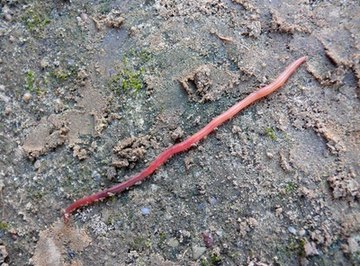
Though they look like relatively simplistic organisms, you might be surprised to find that earthworms have pretty complex and extensive biology. These segmented invertebrates have a respiratory system to oxygenate their bodies, a circulatory system to control the flow of blood, a digestive system to process nutrients and an excretory system to remove waste from their bodies.
Earthworm Behavior
Earthworms burrow through the soil searching for food. Their burrowing actions create small tunnels in the ground that help aerate the soil and transport nutrients to the roots of the plants in an ecosystem.
Earthworms feed on dead and decaying organic matter in the soil, such as fallen leaves. As the organic matter moves through the worm's digestive system, the worm converts some of the nutrients it doesn't use itself into forms that plants can absorb. They expel these nutrients through their excretory system.
Excretory System of Earthworms
What goes in must come out! Worms excrete waste from their bodies back into the soil, and this waste is known as castings. The excretory system of earthworms removes two primary types of "wastes": carbon dioxide and nitrogenous waste. Earthworms use diffusion to excrete carbon dioxide through their skin. For the nitrogenous wastes, the excretory system of earthworms contains specialized organs known as nephridia.
Nephridia Definition
The nephridia are a series of tube-shaped coiled organs within an earthworm's body that it uses to excrete waste. You can find nephridia in earthworms along nearly every segment on their bodies.
If you look at a nephridia diagram, you will see a pore that opens to the exterior of the body, a bladder that holds the collected waste until it's expelled, a coiled tubule that transports the waste to the bladder and a ciliated funnel that uses fine cilia to trap and begin transporting the waste. The ciliated funnel is also known as the nephrostome.
Types of Nephridia: Septal Nephridia
The excretory system of earthworms contains several different types of nephridia based on their location in the body. The septal nephridia of earthworms are located in the thin partition between the segments, known as the septum. Septal nephridia are present on both sides of the septum. A single septum can contain as many as 100 septal nephridia on its surface, with 40 to 50 nephridia on each side of the septum.
Types of Nephridia: Integumentary Nephridia
You can find integumentary nephridia within the segments of the earthworm's body. Unlike the septal nephridia, integumentary nephridia attach to the lining of the body wall rather than the septum. The average segment contains between 200 and 250 integumentary nephridia, with the exception of the non-segmented clitellum region, where their numbers reach well into the thousands.
These nephridia also differ from septal nephridia in their shape and size. Integumentary nephridia are smaller and lack a ciliated funnel.
Types of Nephridia: Pharyngeal Nephridia
Finally, the pharyngeal nephridia appear in pairs alongside the pharynx of the earthworm within the alimentary canal. Though these nephridia are similar in size to the septal nephridia, they lack a ciliated funnel. Researchers have found that in some species, these nephridia contain digestive enzymes and potentially function in a similar fashion to salivary glands.
The decaying organic matter that earthworms feed on contains nutrients vital to plant survival, but the plants cannot utilize the nutrients in that form. During the digestion and excretion process, earthworms convert those nutrients into useable forms and return them back to the soil, creating a healthier environment for plant life and improving the ecosystem. They indirectly improve the health of plants through their excretory system and directly provide prey to numerous animal species.
References
About the Author
Marina Somma is a freelance writer and animal trainer. She holds a B.A. in Psychology and a B.S. in Marine and Environmental Biology & Policy from Monmouth University. Marina has worked with a number of publications involving animal science, behavior and training, including animals.net, SmallDogsAcademy and more.
Photo Credits
earthworm image by ril from Fotolia.com
